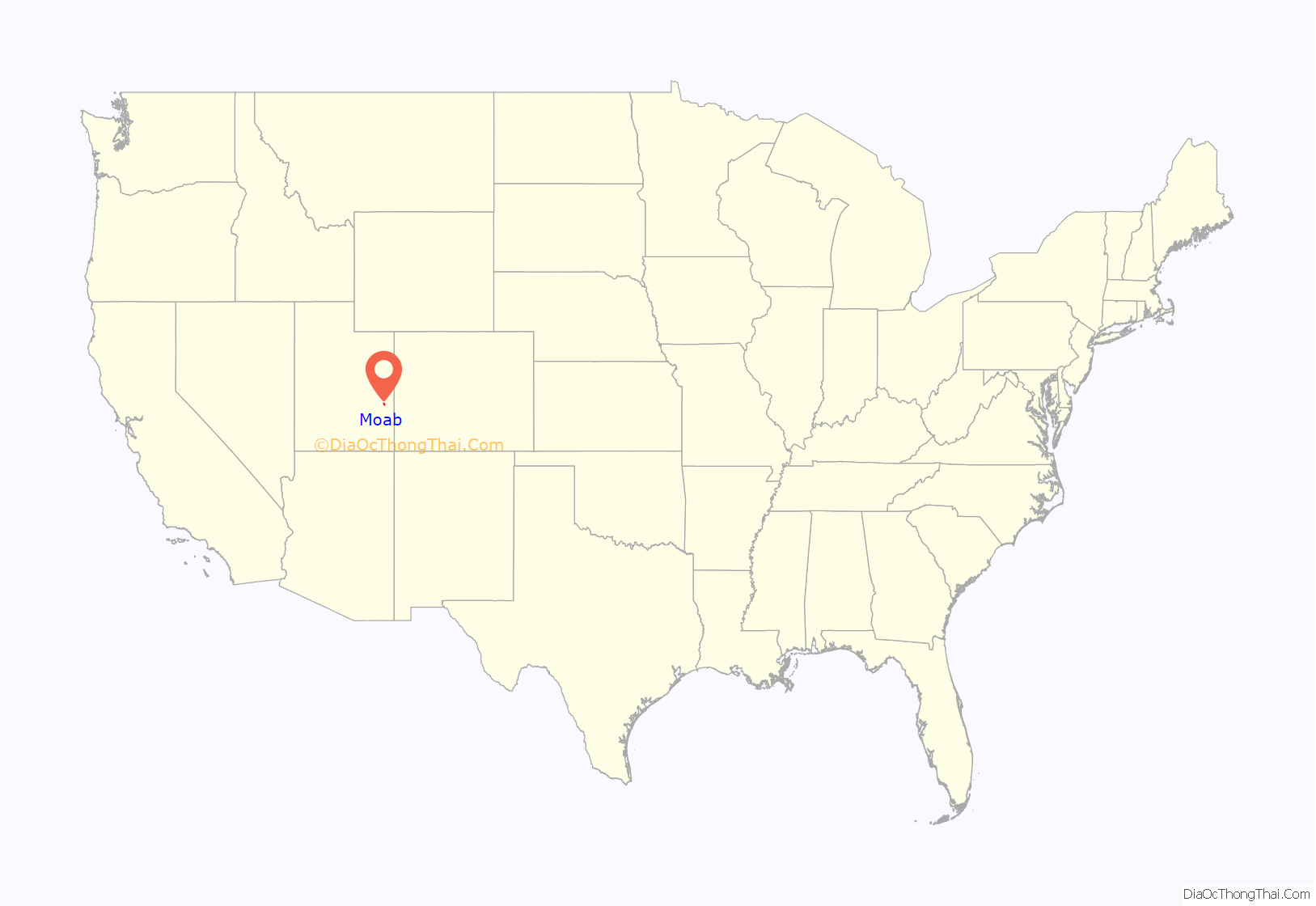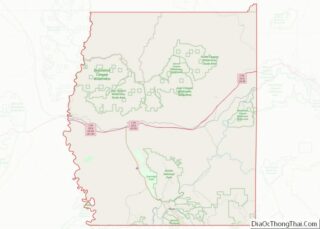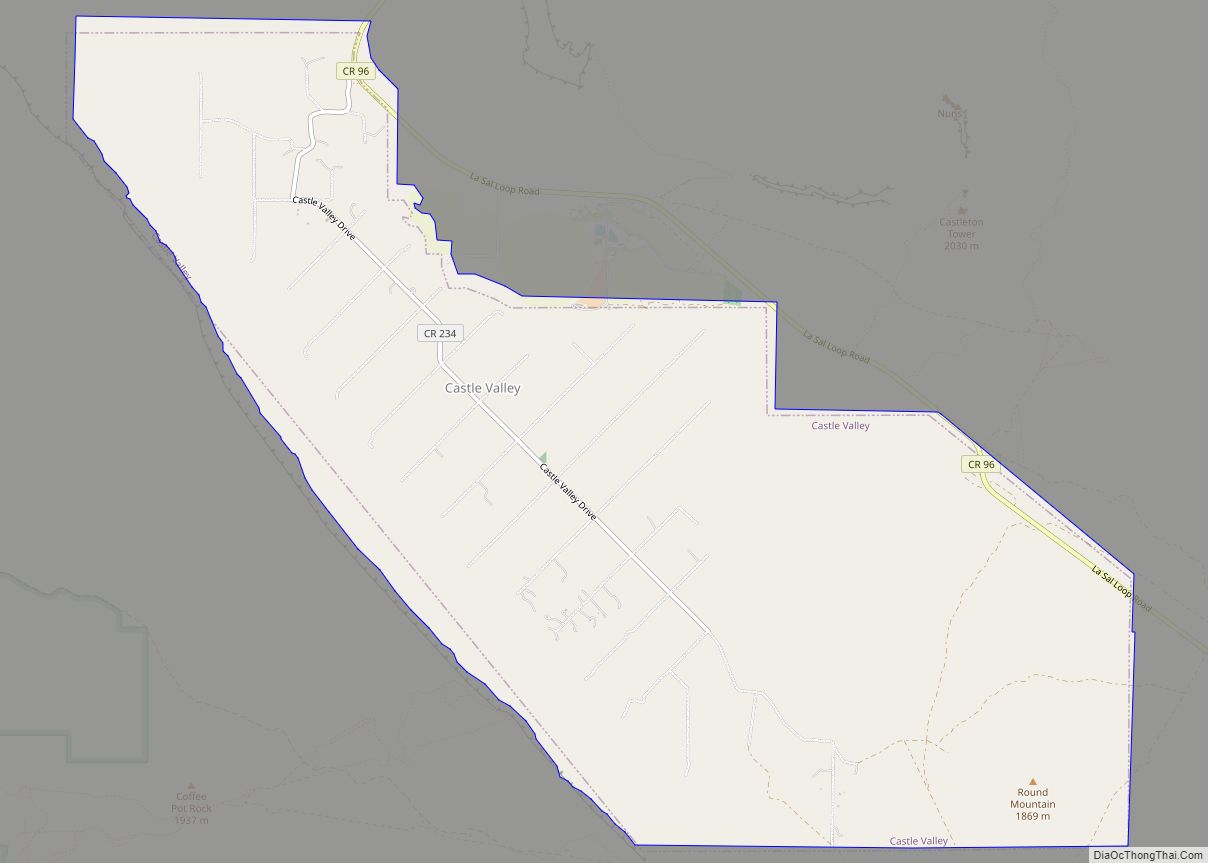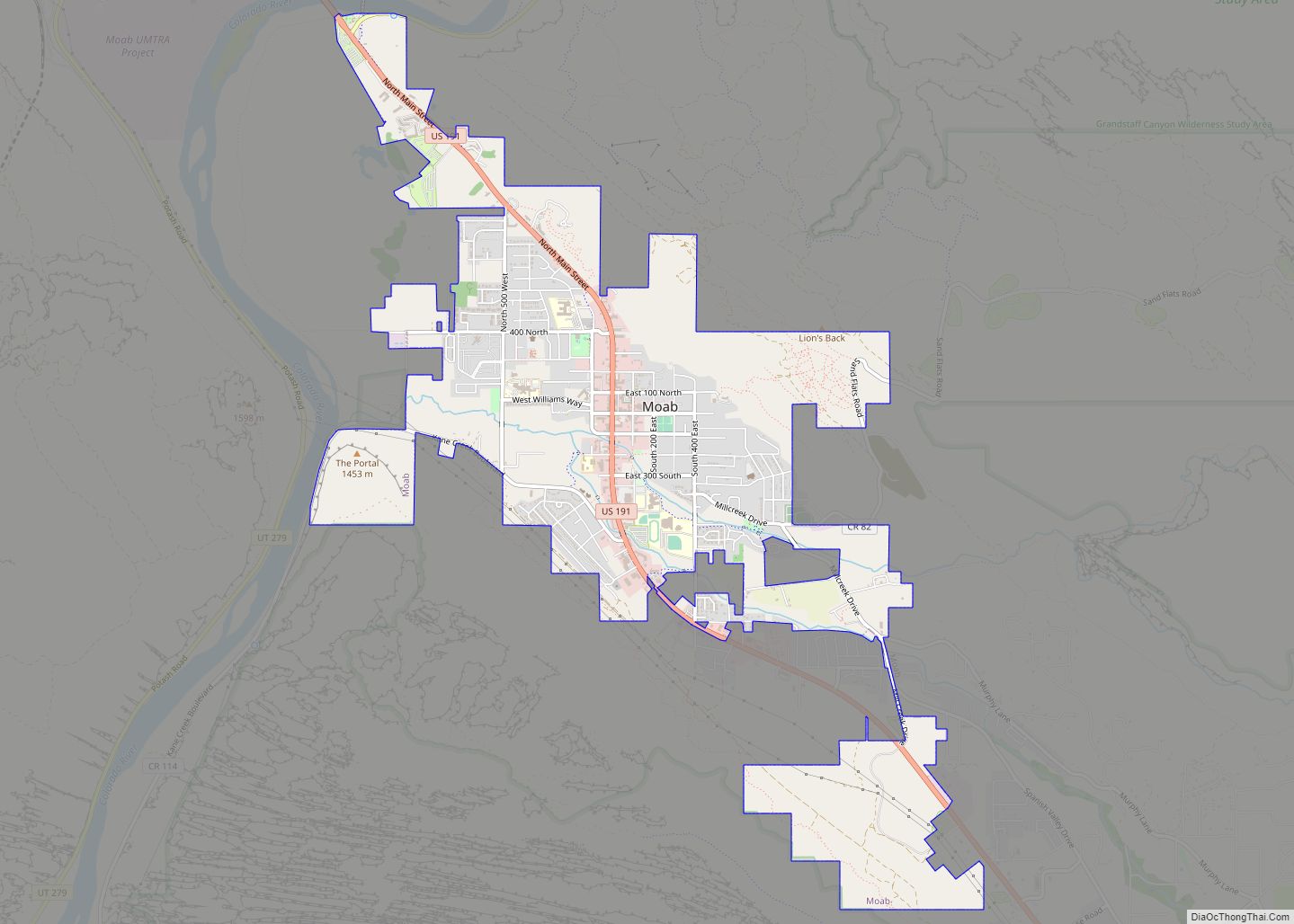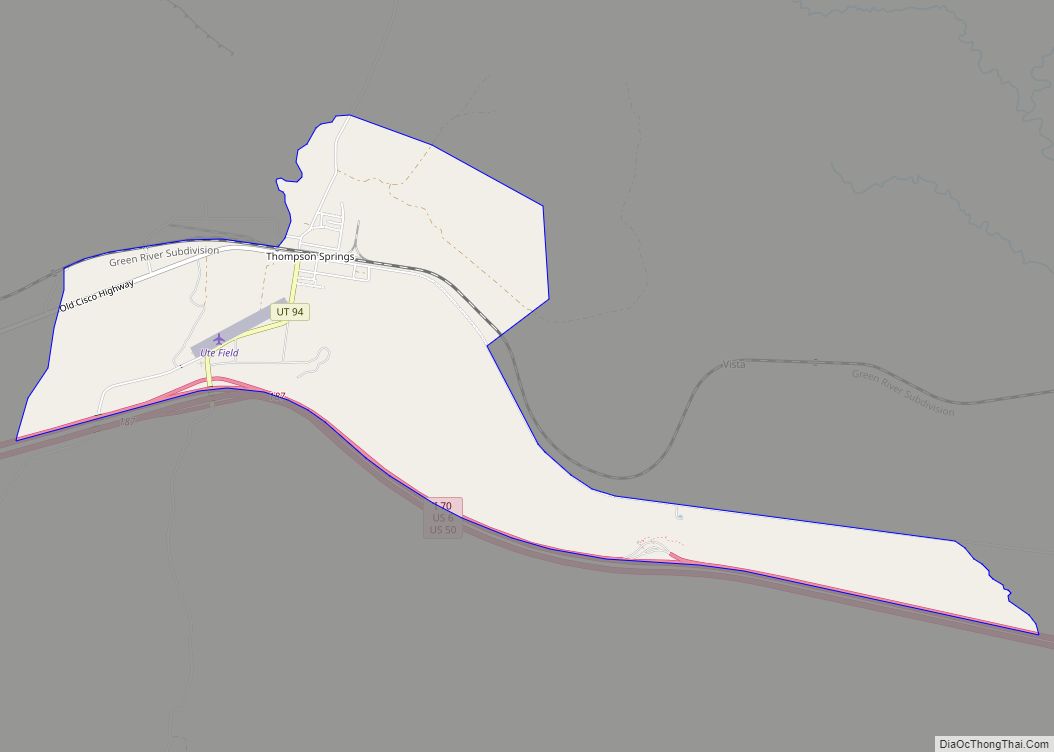Moab (/ˈmoʊ.æb/ (listen)) is the largest city and county seat of Grand County in eastern Utah in the western United States, known for its dramatic scenery. The population was 5,366 at the 2020 census. Moab attracts many tourists annually, mostly visitors to the nearby Arches and Canyonlands National Parks. The town is a popular base for mountain bikers who ride the extensive network of trails including the Slickrock Trail, and for off-roaders who come for the annual Moab Jeep Safari.
| Name: | Moab city |
|---|---|
| LSAD Code: | 25 |
| LSAD Description: | city (suffix) |
| State: | Utah |
| County: | Grand County |
| Incorporated: | 1902 |
| Elevation: | 4,026 ft (1,227 m) |
| Total Area: | 4.80 sq mi (12.42 km²) |
| Land Area: | 4.80 sq mi (12.42 km²) |
| Water Area: | 0.00 sq mi (0.00 km²) |
| Total Population: | 5,366 |
| Population Density: | 1,117.92/sq mi (432.05/km²) |
| ZIP code: | 84532 |
| Area code: | 435 |
| FIPS code: | 4950700 |
| GNISfeature ID: | 1430389 |
| Website: | moabcity.org |
Online Interactive Map
Click on ![]() to view map in "full screen" mode.
to view map in "full screen" mode.
Moab location map. Where is Moab city?
History
Early years
The Biblical name Moab refers to an area of land located on the eastern side of the Jordan River. Some historians believe the city in Utah came to use this name because of William Andrew Peirce, the first postmaster, believing that the biblical Moab and this part of Utah were both “the far country”. However, others believe the name has Paiute origins, referring to the word moapa, meaning “mosquito”. Some of the area’s early residents attempted to change the city’s name, because in the Christian Bible, Moabites are demeaned as incestuous and idolatrous (but note, Ruth was a Moabite). One petition in 1890 had 59 signatures and requested a name change to “Vina”. Another effort attempted to change the name to “Uvadalia”. Both attempts failed.
During the period between 1829 and the early 1850s, the area around what is now Moab served as the Colorado River crossing along the Old Spanish Trail. Latter-day Saint settlers attempted to establish a trading fort at the river crossing called the Elk Mountain Mission in April 1855 to trade with travellers attempting to cross the river. Forty men were called on this mission. There were repeated Indian attacks, including one on September 23, 1855, in which James Hunt, companion to Peter Stubbs, was shot and killed by a Native American. After this last attack, the fort was abandoned. A new group of settlers from Rich County, led by Randolph Hockaday Stewart, established a permanent settlement in 1878 under the direction of Brigham Young. Moab was incorporated as a town on December 20, 1902.
In 1883 the Denver and Rio Grande Western Railroad main line was constructed across eastern Utah. The rail line did not pass through Moab, instead passing through the towns of Thompson Springs and Cisco, 40 miles (64 km) to the north. Later, other places to cross the Colorado were constructed, such as Lee’s Ferry, Navajo Bridge and Boulder Dam. These changes shifted the trade routes away from Moab. Moab farmers and merchants had to adapt from trading with passing travelers to shipping their goods to distant markets. Soon Moab’s origins as one of the few natural crossings of the Colorado River were forgotten. Nevertheless, the U.S. military deemed the bridge over the Colorado River at Moab important enough to place it under guard as late as World War II.
In 1943, a former Civilian Conservation Corps camp outside Moab was used as a Citizen Isolation Center to confine Japanese American internees labeled “troublemakers” by authorities in the War Relocation Authority, the government body responsible for overseeing the wartime incarceration program. The Moab Isolation Center for “noncompliant” Japanese Americans was created in response to growing resistance to WRA policies within the camps; a December 1942 clash between guards and inmates known as the “Manzanar Riot,” in which two were killed and ten injured, was the final push. On January 11, 1943, the sixteen men who had initiated the two-day protests were transferred to Moab from the town jails where they were booked (without charges or access to hearings) after the riot. Having closed just fifteen months prior, all 18 military-style structures of the CCC camp were in good condition, and the site was converted to its new use with minimal renovation. 150 military police guarded the camp, and director Raymond Best and head of security Francis Frederick presided over administration. On February 18, thirteen transfers from Gila River, Arizona, were brought to Moab, and six days later, ten more arrived from Manzanar. An additional fifteen Tule Lake inmates were transferred on April 2. Most of these new arrivals were removed from the general camp population because of their resistance to the WRA’s attempts to determine the loyalty of incarcerated Japanese Americans, met largely with confusion and anger because of a lack of explanation as to how and why internees would be assessed. The Moab Isolation Center remained open until April 27, when most of its inmates were bused to the larger and more secure Leupp Isolation Center. (Five men, serving sentences in the Grand County Jail after protesting conditions in Moab, were transported to Leupp in a five-by-six-foot box on the back of a truck. Their separate transfer was arranged by Francis Frederick, who had also handed down their prison sentences, using a law he later rescinded to charge them with unlawful assembly.) In 1994, the “Dalton Wells CCC Camp/Moab Relocation Center” was added to the National Register of Historic Places, and, although no marker exists on the site, an information plaque at the current site entrance and a photograph on display at the Dan O’Laurie Museum in Moab mention the former isolation center.
Later years
Moab’s economy was originally based on agriculture, but gradually shifted to mining. Uranium and vanadium were discovered in the area in the 1910s and 1920s. Potash and manganese came next, and then oil and gas were discovered. In the 1950s Moab became the so-called “Uranium Capital of the World” after geologist Charles Steen found a rich deposit of uranium ore south of the city. This discovery coincided with the advent of the era of nuclear weapons and nuclear power in the United States, and Moab’s boom years began.
The city population grew nearly 500% over the next few years, bringing the population to near 6,000 people. The explosion in population caused much construction of houses and schools. Charles Steen donated a great deal of money and land to create new houses and churches in Moab.
With the winding down of the Cold War, Moab’s uranium boom was over, and the city’s population drastically declined. By the early 1980s a number of homes stood empty, and nearly all of the uranium mines had closed.
In 1949, Western movie director John Ford was persuaded to use the area for the movie Wagon Master. Ford had been using the area in Monument Valley around Mexican Hat, Utah, south of Moab, since he filmed Stagecoach there 10 years earlier in 1939. A local Moab rancher (George White) found Ford and persuaded him to come take a look at Moab. The Moab to Monument Valley Film Commission is a Moab City Department and holds the title of the longest running film commission in the world. Established in 1949, the commission has overseen the production of the many movies filmed near Moab.
In recent years, Moab has experienced a surge of second-home owners. The relatively mild winters and enjoyable summers have attracted many people to build such homes throughout the area. In a situation mirroring that of other resort towns in the American West, controversy has arisen over these new residents and their houses, which in many cases remain unoccupied for most of the year. Many Moab citizens are concerned that the town is seeing changes similar to those experienced in Vail and Aspen in neighboring Colorado: skyrocketing property values, a rising cost of living, and corresponding effects on local low- and middle-income workers.
Charlie Steen’s $11 million Uranium Reduction Co. that became the Atlas Uranium Mill
County-sponsored sign promoting manufacturing in Moab during the early 1970s
Uranium building’s historic storefront, 2019
A rock shop, 2019
Moab Road Map
Moab city Satellite Map
Geography
Moab is just south of the Colorado River, at an elevation of 4,025 feet (1,227 m) on the Colorado Plateau. It is 18 miles (29 km) west of the Utah/Colorado state line. Via U.S. Route 191, it is 31 miles (50 km) south of Interstate 70 at Crescent Junction, and it is 54 miles (87 km) north of Monticello. Via Utah State Route 128 it is 46 miles (74 km) southwest of Cisco. The entrance to Arches National Park is 4 miles (6 km) north of Moab on US 191. Hurrah Pass is located on the trail between Moab and Chicken Corners.
According to the United States Census Bureau, the city has a total area of 12 square kilometres (4.8 sq mi), all land.
Climate
Moab has a semi-arid climate bordering on arid (Köppen BSk) characterized by hot summers and chilly winters, with precipitation evenly spread over the year (usually less than one inch per month). There are an average of 41 days with temperatures reaching 100 °F (38 °C), 109 days reaching 90 °F (32 °C), and 3.6 days per winter where the temperature remains at or below freezing. The highest temperature was 114 °F (46 °C) on July 7, 1989. The lowest temperature was −24 °F (−31 °C) on January 22, 1930.
Average annual precipitation in Moab is 9.02 inches (229 mm). There are an average of 55 days annually with measurable precipitation. The wettest year was 1983 with 16.42 inches (417 mm) and the driest year was 1898 with 4.32 inches (110 mm). The most precipitation in one month was 6.63 inches (168 mm) in July 1918. The most precipitation in 24 hours was 2.77 in (70 mm) on July 23, 1983.
Average seasonal snowfall for 1981–2011 is 6.9 inches (18 cm). The most snow in a season was 74 in (190 cm) during 1914–15, and the snowiest month on average is December, with the record set in 1915 at 46.0 in (117 cm).
See also
Map of Utah State and its subdivision: Map of other states:- Alabama
- Alaska
- Arizona
- Arkansas
- California
- Colorado
- Connecticut
- Delaware
- District of Columbia
- Florida
- Georgia
- Hawaii
- Idaho
- Illinois
- Indiana
- Iowa
- Kansas
- Kentucky
- Louisiana
- Maine
- Maryland
- Massachusetts
- Michigan
- Minnesota
- Mississippi
- Missouri
- Montana
- Nebraska
- Nevada
- New Hampshire
- New Jersey
- New Mexico
- New York
- North Carolina
- North Dakota
- Ohio
- Oklahoma
- Oregon
- Pennsylvania
- Rhode Island
- South Carolina
- South Dakota
- Tennessee
- Texas
- Utah
- Vermont
- Virginia
- Washington
- West Virginia
- Wisconsin
- Wyoming
